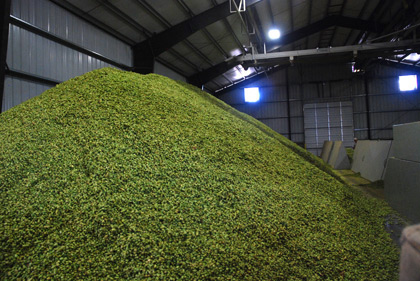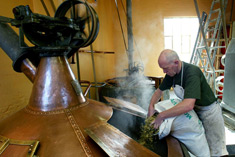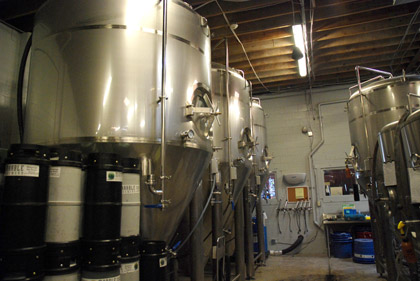
You are looking at more than 25 tons of hops on the cooling floor at Loftus Ranches in Washington’s Yakima Valley last Friday. This is what they mean when they say “green gold.”
I was in the Northwest last week first of all to speak at Hop Union’s Hop & Brew School (“Hop Aroma & Flavor: BC [Before Cascade] and AD [After Dank]). Since Hop Union paid my way to get there I added a few days to visit hop farmers in both Washington and Oregon and get an update on the brewery at Mount Angel Abbey. A five-barrel brewhouse is due to arrive before the end of the year, which might be before the brewing space it ready. The monks should be pleased if they have beer to sell when Mount Angel hosts is massive Oktoberfest next September.
But back to hops, and a few links.
– Sixpoint Brewery in Brooklyn used Mosaic (readers’ choice) for a “wet hop” beer called Autumnation, and a wrote a bit for their blog. I’ll let you know what I think of the beer after I taste it.
– It seems there are stories about “wet hopped beers” at every turn these days. I like this one from Long Island, even thought it is not at all clear we can call “small-scale hop farming economically viable.”
– Shepherd Neame will host the first UK Hop Symposium on Oct. 3. Tony Redsell, Peter Darby and a day in and around Faversham, Kent — wish it weren’t 4,000 miles away. In addition, Eddie Gadd of the Ramsgate Brewery will talk about the Kent Green Hop Beer Fortnight.
– Roger Protz profiles Ali Capper, who is determined to keep British hops relevant to brewers in the UK and elsewhere (particularly the US).
– You may have already read about it, but Sierra Nevada’s first Single Fresh, Wet & Wild Harvest Festival (sorry, you’ll have to fill in your birth date) next month will bring even more attention to the to unkilned hops.
– Although breweries from all over the country are shipping beer to the Sierra Nevada party if Scotty were to beam me to one festival it would be the Hood River Hops Festival. Beers from breweries almost all right the middle of Hop Country next Saturday (Sept. 28). For an idea of what might be served, Jeff Alworth is keeping a running list of what’s being served in Beervana.

